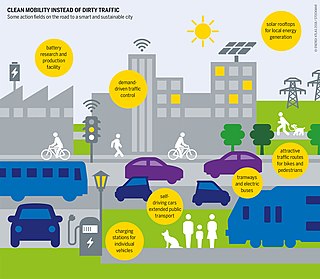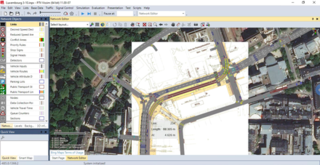
Transport economics is a branch of economics founded in 1959 by American economist John R. Meyer that deals with the allocation of resources within the transport sector. It has strong links to civil engineering. Transport economics differs from some other branches of economics in that the assumption of a spaceless, instantaneous economy does not hold. People and goods flow over networks at certain speeds. Demands peak. Advance ticket purchase is often induced by lower fares. The networks themselves may or may not be competitive. A single trip may require the bundling of services provided by several firms, agencies and modes.

An intelligent transportation system (ITS) is an advanced application that aims to provide innovative services relating to different modes of transport and traffic management and enable users to be better informed and make safer, more coordinated, and 'smarter' use of transport networks.

A ramp meter, ramp signal, or metering light is a device, usually a basic traffic light or a two-section signal light together with a signal controller, that regulates the flow of traffic entering freeways according to current traffic conditions. Ramp meters are used at freeway on-ramps to manage the rate of automobiles entering the freeway. Ramp metering systems have proved to be successful in decreasing traffic congestion and improving driver safety.

Congestion pricing or congestion charges is a system of surcharging users of public goods that are subject to congestion through excess demand, such as through higher peak charges for use of bus services, electricity, metros, railways, telephones, and road pricing to reduce traffic congestion; airlines and shipping companies may be charged higher fees for slots at airports and through canals at busy times. Advocates claim this pricing strategy regulates demand, making it possible to manage congestion without increasing supply.

Sustainable transport refers to ways of transportation that are sustainable in terms of their social and environmental impacts. Components for evaluating sustainability include the particular vehicles used for road, water or air transport; the source of energy; and the infrastructure used to accommodate the transport. Transport operations and logistics as well as transit-oriented development are also involved in evaluation. Transportation sustainability is largely being measured by transportation system effectiveness and efficiency as well as the environmental and climate impacts of the system. Transport systems have significant impacts on the environment, accounting for between 20% and 25% of world energy consumption and carbon dioxide emissions. The majority of the emissions, almost 97%, came from direct burning of fossil fuels. In 2019, about 95% of the fuel came from fossil sources. The main source of greenhouse gas emissions in the European Union is transportation. In 2019 it contributes to about 31% of global emissions and 24% of emissions in the EU. In addition, up to the COVID-19 pandemic, emissions have only increased in this one sector. Greenhouse gas emissions from transport are increasing at a faster rate than any other energy using sector. Road transport is also a major contributor to local air pollution and smog.

Transportation demand management or travel demand management (TDM) is the application of strategies and policies to increase the efficiency of transportation systems, that reduce travel demand, or to redistribute this demand in space or in time.
The Sydney Coordinated Adaptive Traffic System, abbreviated SCATS, is an intelligent transportation system that manages the dynamic timing of signal phases at traffic signals, meaning that it tries to find the best phasing for a traffic situation. SCATS is based on the automatic plan selection from a library in response to the data derived from loop detectors or other road traffic sensors.
Traffic estimation and prediction systems (TrEPS) have the potential to improve traffic conditions and reduce travel delays by facilitating better utilization of available capacity. These systems exploit currently available and emerging computer, communication, and control technologies to monitor, manage, and control the transportation system. They also provide various levels of traffic information and trip advisory to system users, including many ITS service providers, so that travelers can make timely and informed travel decisions.

Transportation forecasting is the attempt of estimating the number of vehicles or people that will use a specific transportation facility in the future. For instance, a forecast may estimate the number of vehicles on a planned road or bridge, the ridership on a railway line, the number of passengers visiting an airport, or the number of ships calling on a seaport. Traffic forecasting begins with the collection of data on current traffic. This traffic data is combined with other known data, such as population, employment, trip rates, travel costs, etc., to develop a traffic demand model for the current situation. Feeding it with predicted data for population, employment, etc. results in estimates of future traffic, typically estimated for each segment of the transportation infrastructure in question, e.g., for each roadway segment or railway station. The current technologies facilitate the access to dynamic data, big data, etc., providing the opportunity to develop new algorithms to improve greatly the predictability and accuracy of the current estimations.

PTV Vissim is a microscopic multi-modal traffic flow simulation software package developed by PTV Planung Transport Verkehr AG in Karlsruhe, Germany. It was first developed in 1992. The name is derived from "Verkehr In Städten - SIMulationsmodell".

Active mobility, soft mobility, active travel, active transport or active transportation is the transport of people or goods, through non-motorized means, based around human physical activity. The best-known forms of active mobility are walking and cycling, though other modes include running, rowing, skateboarding, kick scooters and roller skates. Due to its prevalence, cycling is sometimes considered separately from the other forms of active mobility.
PTV Planung Transport Verkehr GmbH is a German company specializing in software and consulting services for traffic and transportation and mobility. Their transport planning software, Vision Traffic Suite comprise the PTV Group's product portfolio. According to the manufacturer; over 2,500 customers in more than 120 countries use the Vision Traffic Suite in the fields of transport modelling and traffic flow calculation. PTV ranks among the top 1,000 global market leaders in Germany according to Germany's Manager Magazine.
Urban freight distribution is the system and process by which goods are collected, transported, and distributed within urban environments. The urban freight system can include seaports, airports, manufacturing facilities, and warehouse/distribution centers that are connected by a network of railroads, rail yards, pipelines, highways, and roadways that enable goods to get to their destinations.
Urban traffic modeling and analysis is part of the advanced traffic intelligent management technologies that has become a crucial sector of Traffic management and control. Its main purpose is to predict congestion states of a specific urban transport network and propose improvements in the traffic network. Researches rely on three different informations. Historical and recent information of a traffic network about its density and flow, a model of the transport network infrastructure and algorithms referring to both spatial and temporal dimensions. The final objective is to provide a better optimization of the traffic infrastructure such as traffic lights. Those optimizations should result into a decrease of the travel times, pollution and fuel consumption.

Simulation of Urban MObility is an open source, portable, microscopic and continuous multi-modal traffic simulation package designed to handle large networks. SUMO is developed by the German Aerospace Center and community users. It has been freely available as open-source since 2001, and since 2017 it is an Eclipse Foundation project.
Carolina Osorio is a full professor in Decision Sciences at HEC Montreal. Her work is focused on operations research applied to urban transportation.

Michel Bierlaire is a Belgian-Swiss applied mathematician specialized in transportation modeling and optimization. He is a professor at EPFL and the head of the Transport and Mobility Laboratory.
Aimsun is a software company that provides simulation software and services for transportation planning and traffic management.
Autonomous mobility on demand (AMoD) is a service consisting of a fleet of autonomous vehicles used for one-way passenger mobility. An AMoD fleet operates in a specific and limited environment, such as a city or a rural area.

Baher Abdulhai is a Canadian civil engineer, academic, entrepreneur, and researcher. He is a professor in the Department of Civil Engineering, Director of Intelligent Transportation Systems Centre, and Co-Director of iCity Centre for Automated and Transformative Transportation at the University of Toronto. He is also the CEO and managing director of IntelliCAN Transportation System Inc.












